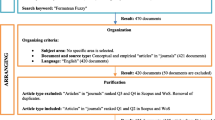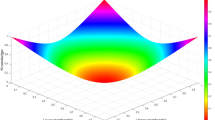Abstract
Predictive analysis is vital for decision management especially when involving in multiple attributes information systems. The correlation between attributes reflects that there exists a certain association between attributes and objects. How to effectively use the correlation between attributes to guide the prediction is a hot research topic in predictive analysis. In this paper, based on the designed attribute-oriented rough fuzzy set (RFS) model, a new multi-attribute predictive analysis approach is put forward for dealing with multi-attribute fuzzy information systems. This approach uses δ-fuzzy similarity classes to gather attributes with strong correlation to construct a new RFS model. Moreover, two prediction directions are constructed on the basis of the lower and upper approximations of the new RFS model. By analyzing the cosine distances between alternative and pessimistic and optimistic prediction directions, a trend predictive function is designed to forecast the development trend of the alternative. In the process of model building, trend prediction is carried out based on certain semantic information, which shows that the prediction model has certain interpretability. To evaluate the performance of the proposed multi-attribute predictive analysis model, experiments with UCI datasets are conducted for analysis and discussion. The obtained experimental results indicate that the established predictive analysis model is feasible and satisfactory.










Similar content being viewed by others
References
Yolca OC, Alpaslan F (2018) Prediction of TAIEX based on hybrid fuzzy time series model with single optimization process. Appl Soft Comput 66:18–33
Chen F, Yang Y, Tang B, Chen B, Xiao W (2020) Performance degradation prediction of mechanical equipment based on optimized multi-kernel relevant vector machine and fuzzy information granulation. Measurement 151:107116
Qiang S, Chissom BS (1993) Fuzzy time series and its models. Fuzzy Sets Syst 54(3):269–277
Zadeh LA (1965) Fuzzy sets. Inf Control 8(3):338–353
Tinh NV (2020) Enhanced Forecasting accuracy of fuzzy time series model based on combined fuzzy C-mean clustering with particle swam optimization. Int J Comput Intell Appl 19(2):2050017
de Carvalho Tavares THB, Ferreira BP, Mendes EMAM (2022) Fuzzy time series model based on redcblack trees for stock index forecasting. Appl Soft Comput 127:109323
Wei LA, Ju HB, Lx A, St B, Lp A (2019) International roughness index prediction based on multigranularity fuzzy time series and particle swarm optimization. Expert Syst Appl X 2:100006
Cheng CH, Yang JH (2018) Fuzzy Time-series model based on rough set rule induction for forecasting stock price. Neurocomputing 302:33–45
Alyousifi Y, Othman M, Husin A, Rathnayake U (2021) A new hybrid fuzzy time series model with an application to predict PM10 concentration. Ecotoxicol Environ Saf 227:112875
Kumar N, Kumar H (2021) A novel hybrid fuzzy time series model for prediction of COVID-19 infected cases and deaths in India. ISA Trans 124:69–81
Cao B, Zhao J, Lv Z, Gu Y, Yang P, Halgamuge SK (2020) Multiobjective evolution of fuzzy rough neural network via distributed parallelism for stock prediction. IEEE Trans Fuzzy Syst 28(5):939–952
Sun B, Bai J, Chu X, Sun S, Li Y, Li H (2022) Interval prediction approach to crude oil price based on three-way clustering and decomposition ensemble learning. Appl Soft Comput 123:108933
Deng JL (1982) Introduction to grey system theory. J Grey Syst 1(1):1–24
Li K, Zhang T (2019) A novel grey forecasting model and its application in forecasting the energy consumption in Shanghai. Energy Syst (3):1–16
Zhu H (2021) Multi-parameter grey prediction model based on the derivation method. Appl Math Model 97:588–601
Wu LZ, Li SH, Huang RQ, Xu Q (2020) A new grey prediction model and its application to predicting landslide displacement. Appl Soft Comput 95:106543
Ding S, Li R, Tao Z (2021) A novel adaptive discrete grey model with time-varying parameters for long-term photovoltaic power generation forecasting. Energy Convers Manag 227:113644
Zhou W, Jiang R, Ding S, Cheng Y, Tao H (2021) A novel grey prediction model for seasonal time series. Knowl-Based Syst 229(1):107363
Wei H, Hu C, Chen S, Xue Y, Zhang Q (2019) Establishing a software defect prediction model via effective dimension reduction. Inf Sci 477:399–409
Cheng M, Cao M, Mendrofa A (2021) Dynamic feature selection for accurately predicting construction productivity using symbiotic organisms search-optimized least square support vector machine. J Build Eng 35:101973
Alkhayat G, Mehmood R (2021) A review and taxonomy of wind and solar energy forecasting methods based on deep learning. Energy and AI (7):100060
Wang Y, Zou R, Liu F, Zhang L, Liu Q (2021) A review of wind speed and wind power forecasting with deep neural networks. Appl Energy 304(1):117766
Pawlak Z (1982) Rough sets. Int J Comput Inform Sci 11(5):341–356
Kundu S, Pal SK (2018) Double bounded rough set, tension measure, and social link prediction. IEEE Trans Comput Soc Syst 5(3):841–853
Chu X, Sun B, Li X, Han K, Huang Q (2020) Neighborhood rough set-based three-way clustering considering attribute correlations: an approach to classification of potential gout groups. Inf Sci 535:28–41
Bai J, Sun B, Chu X, Wang T, Li H, Huang Q (2022) Neighborhood rough set-based multi-attribute prediction approach and its application of gout patients. Appl Soft Comput 114:108127
Jahangir H, Tayarani H, Ahmadian A, Golkar MA, Miret J, Tayarani M, Gao HO (2019) Charging demand of plug-in electric vehicles: forecasting travel behavior based on a novel rough artificial neural network approach. J Clean Prod 229:1029–1044
Błaszczyński J, de Almeida Filho AT, Matuszyk A, Szela̧g M, Słowiński R (2021) Auto loan fraud detection using dominance-based rough set approach versus machine learning methods. Expert Syst Appl 163:113740
Bai Y, Xie J, Wang D, Zhang W, Li C (2021) A manufacturing quality prediction model based on AdaBoost-LSTM with rough knowledge. Comput Ind Eng 155:107227
Albuquerque LG, Roque F, Valente-Neto F, Koroiva R, Pinto J (2021) Large-scale prediction of tropical stream water quality using rough sets theory. Ecol Inform 61(80):101226
Attia AF, Elaziz MA, Hassanien AE, El-Sehiemy RA (2020) Prediction of solar activity using hybrid artificial bee colony with neighborhood rough sets. IEEE Trans Comput Soc Syst 7(5):1123–1130
Zhao B, Yi R, Gao D, Xu L (2019) Prediction of service life of large centrifugal compressor remanufactured impeller based on clustering rough set and fuzzy bandelet neural network. Appl Soft Comput 78:132–140
Lei L, Chen W, Wu B, Chen C, Liu W (2021) A building energy consumption prediction model based on rough set theory and deep learning algorithms. Energy Build 240(10):110886
Khodayar M, Saffari M, Williams M, Jalali SMJ (2022) Interval deep learning architecture with rough pattern recognition and fuzzy inference for short-term wind speed forecasting. Energy 254:124143
Sheikhoushaghi A, Gharaei NY, Nikoofard A (2022) Application of rough neural network to forecast oil production rate of an oil field in a comparative study. J Petrol Sci Eng 209:109935
Dubois D, Prade H (1990) Rough fuzzy sets and fuzzy rough sets. Int J Gen Syst 17 (2-3):191–209
Halder A, Kumar A (2019) Active learning using rough fuzzy classifier for cancer prediction from microarray gene expression data. J Biomed Inform 92:103136
Yu B, Guo L, Li Q (2019) A characterization of novel rough fuzzy sets of information systems and their application in decision making. Expert Syst Appl 122:253–261
Yu B, Cai M, Dai J, Li Q (2020) A novel approach to predictive analysis using attribute-oriented rough fuzzy sets. Expert Syst Appl 161:113644
Kang Y, Yu B, Cai M (2022) Multi-attribute predictive analysis based on attribute-oriented fuzzy rough sets in fuzzy information systems. Inf Sci 608:931–949
Acknowledgements
This work is supported by Hunan Provincial Natural Science Foundation of China (2020JJ5346).
Author information
Authors and Affiliations
Corresponding author
Additional information
Publisher’s note
Springer Nature remains neutral with regard to jurisdictional claims in published maps and institutional affiliations.
Rights and permissions
Springer Nature or its licensor (e.g. a society or other partner) holds exclusive rights to this article under a publishing agreement with the author(s) or other rightsholder(s); author self-archiving of the accepted manuscript version of this article is solely governed by the terms of such publishing agreement and applicable law.
About this article
Cite this article
Kang, Y., Yu, B. & Xu, Z. A novel approach to multi-attribute predictive analysis based on rough fuzzy sets. Appl Intell 53, 17644–17661 (2023). https://doi.org/10.1007/s10489-022-04360-z
Accepted:
Published:
Issue Date:
DOI: https://doi.org/10.1007/s10489-022-04360-z




